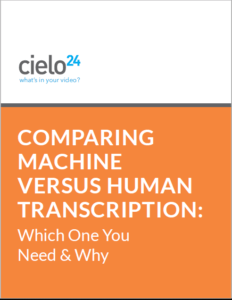Captioned Online Video Is Changing the Game for Media Companies At every level, business growth…

How to Boost Page Loading Performance With Video
It is easy to boost page loading performance in just a few easy steps. Using videos in your landing pages and website content can help boost engagement and conversions, but there’s often an unexpected downside – slow page load times. This is due to several factors – including increased bandwidth requirements, video optimization failure, and the number of elements included on any given page.

This concern over the impact to page loading performance times is valid, too. 47% of consumers expect a web page to load in 2 seconds or less, and 40% of people abandon a website that takes more than 3 seconds to load – especially mobile viewers.
But with videos producing 85% more conversions than landing pages without video, there is more reason to use video on your website than to avoid them. And making sure your videos are correctly placed to boost loading performance times is easier than you might think.
Boost Page Loading Performance: JavaScript and Flash
First of all, it’s essential to understand that search engine crawlers tend to have a hard time indexing Flash and JavaScript-generated content. JavaScript can generate its own interactive transcripts and complex media data, but Google will likely be unable to read your content, which severely inhibits your ability to get a good search result ranking.
Don’t Be Scared of Asynchronous Content
Often web developers will separate page content delivery from web content rendering in order to boost page load time performance. This process is referred to as asynchronous web content rendering, used frequently in AJAX (asynchronous JavaScript and XML) applications.
Before you get intimidated by the technical language, it is not as difficult as it sounds.
Asynchronous content rendering triggers a second stage of rendering by using a resource URL to break-up load time.
Instructions for Using AJAX Rendering to Boost Page Loading

Some solutions can make your AJAX web application crawlable by Google and other search engines. One solution is HTML snapshots, which observes the URL mapping and HTML snapshot scheme described in the Specification section of your app or website, making it visible to the crawler. This involves appending fragments to the URL to allow the crawler to differentiate and index pages with different AJAX-generated content. Implementing HTML snapshots can be a somewhat tricky process, though. You can either:
-
Create static content for each dynamic state, in which case you will need to adopt the #! AJAX URL structure and correctly respond to _escaped_fragment_ requests
- Create content produced through a server-side technology such as PHP or ASP.NET, in which case you will want to include a hash fragment in your URL
- Or through content created on the client-side using JavaScript, in which case you will need a headless browser emulator
JSON-LD EncodingA better, more straightforward solution might be to use the built-in JavaScript method called pushState(), which produces more user-friendly URLs and is more accessible for developers to implement.
You may also be familiar with something called JavaScript Object Notation for Linked Data, or simply JSON-LD, which is a method of encoding Linked Data using JSON. It was a goal to require as little effort as possible from developers to transform their existing JSON to JSON-LD. This allows data to be serialized in a way that is similar to traditional JSON. In straightforward terms, this will enable you to implement rich snippets of media quickly and easily.
The gratifying news here is that instructions are straightforward. However, you may still want to put your webmaster in charge of implementing your media data. 
Instructions for implementing JSON-LD:
- Visit https://developers.google.com/structured-data/rich-snippets/videos to get directions. Scroll down and copy the code under ‘JSON_LD’ tab and paste it into a text editor and update the default information with your own.
- Once updated, insert the code into the head section of your page.
Whichever route you take, the only thing you want to avoid is doing nothing at all. Boosted page loading performance times are essential to your online success, but so are videos. Optimizing each will optimize your overall ROI.
cielo24 Video Transcript Solutions Boost Page Loading Performance
Our Self Serve web app allows you to get started on transcriptions and captions immediately, without the wait for contracts or quotes. Self Serve provides for a preliminary amount of free machine-based transcriptions, and human-verified transcriptions and captions begin at less than $1/minute.
Enterprise plans are built around your specific needs with the help of an account executive to help satisfy more complex and/or more significant amounts of media that need captioning or transcription. Through Enterprise, you also have access to our full suite of video and audio data solutions. Most universities use the Enterprise level account to ensure all the ADA compliance requirements are being fully met. However, the choice is always yours! And the options are there for your selection.
For more information on our video transcription accuracy, captioning and video intelligence solutions, contact us online or call us at 1-855-243-5624.
cielo24 is removing barriers to increase video marketing ROI, searchability, and compliance for all your videos!
Take a Video Captioning test-drive >>




